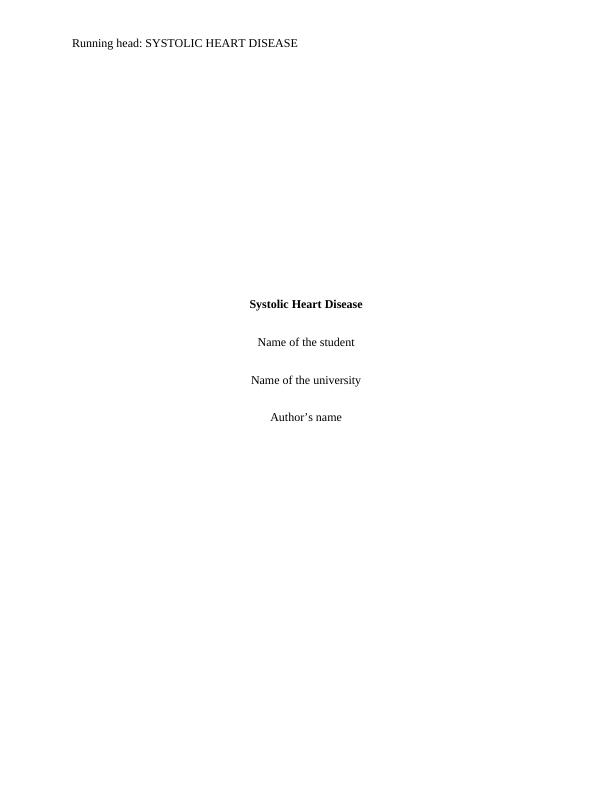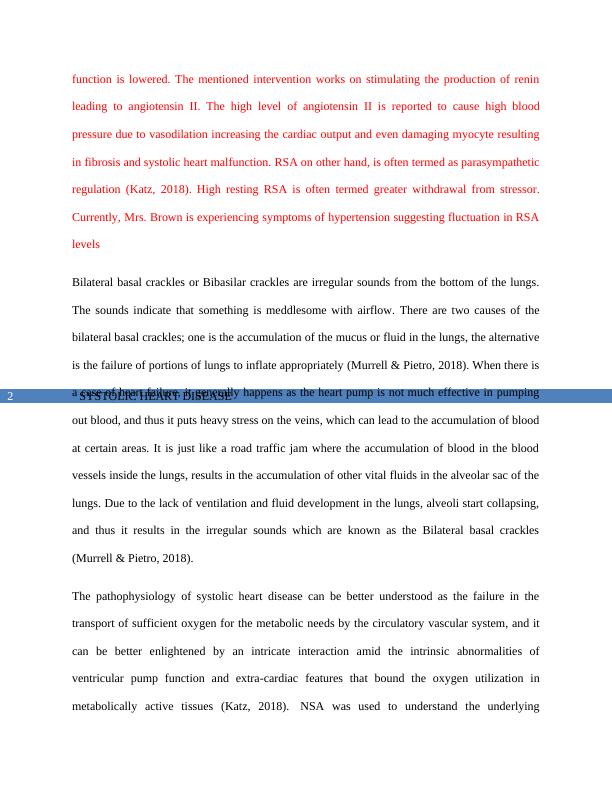Systolic Heart Disease: Pathogenesis, Nursing Strategies, and Drug Mechanism of Action
Added on 2022-10-03
8 Pages1920 Words155 Views
Running head: SYSTOLIC HEART DISEASE
Systolic Heart Disease
Name of the student
Name of the university
Author’s name
Systolic Heart Disease
Name of the student
Name of the university
Author’s name

SYSTOLIC HEART DISEASE1
Q1. Explain the pathogenesis causing the clinical manifestations with which
Mrs. Brown presented. (650)
The case study is about Mrs Brown, who is a 78-year-old lady. According to the case study, Mrs
Brown has been admitted in the hospital because she had severe breathlessness. According to her
medical history, she has been diagnosed with systolic heart disease. On the time of admission,
she showed signs of acute dyspnea. Also, after she was diagnosed with the help of ECG, she
showed atrial fibrillation.
For an adult, the average respiration rate should be in between 12 – 20 breathes per minute, but
Mrs Brown was seen to be having 24 breathes per minute, which is considered to be abnormal.
When a heart beats, it squeezes and pushes blood through the arteries, which flows to the other
part of the body. This force creates pressure on the surface of the blood vessels, and that pressure
is termed as the systolic blood pressure. Average systolic blood pressure is below 120. A range
above 140 can be thought as stage 2 hypertension. Mrs Brown showed a blood pressure of
170/95 mmHg, which tells that she is suffering from hypertension (Yoon et al., 2015).
SpO2 stands for peripheral capillary oxygen saturation. It is an estimate of arterial oxygen
saturation, or SaO2, which refers to the amount of oxygenated haemoglobin in the blood. SpO2
can be measured by pulse oximetry, which is an indirect, non-invasive method. A percentage
represents the value of SpO2. Standard pulse oximeter scale generally varies from 95-100 %.
Values under 90% are considered low. Mrs Brown showed a SpO2 range of 85%, which was
tremendously low, that also in the room air (Beasley et al., 2017). Activation of compensatory
mechanism in order to increase cardiac output is seen to have detrimental effect on health of
Mrs. Brown. The prime intervention is undertaken by RAAS which is activated when heart
Q1. Explain the pathogenesis causing the clinical manifestations with which
Mrs. Brown presented. (650)
The case study is about Mrs Brown, who is a 78-year-old lady. According to the case study, Mrs
Brown has been admitted in the hospital because she had severe breathlessness. According to her
medical history, she has been diagnosed with systolic heart disease. On the time of admission,
she showed signs of acute dyspnea. Also, after she was diagnosed with the help of ECG, she
showed atrial fibrillation.
For an adult, the average respiration rate should be in between 12 – 20 breathes per minute, but
Mrs Brown was seen to be having 24 breathes per minute, which is considered to be abnormal.
When a heart beats, it squeezes and pushes blood through the arteries, which flows to the other
part of the body. This force creates pressure on the surface of the blood vessels, and that pressure
is termed as the systolic blood pressure. Average systolic blood pressure is below 120. A range
above 140 can be thought as stage 2 hypertension. Mrs Brown showed a blood pressure of
170/95 mmHg, which tells that she is suffering from hypertension (Yoon et al., 2015).
SpO2 stands for peripheral capillary oxygen saturation. It is an estimate of arterial oxygen
saturation, or SaO2, which refers to the amount of oxygenated haemoglobin in the blood. SpO2
can be measured by pulse oximetry, which is an indirect, non-invasive method. A percentage
represents the value of SpO2. Standard pulse oximeter scale generally varies from 95-100 %.
Values under 90% are considered low. Mrs Brown showed a SpO2 range of 85%, which was
tremendously low, that also in the room air (Beasley et al., 2017). Activation of compensatory
mechanism in order to increase cardiac output is seen to have detrimental effect on health of
Mrs. Brown. The prime intervention is undertaken by RAAS which is activated when heart

SYSTOLIC HEART DISEASE2
function is lowered. The mentioned intervention works on stimulating the production of renin
leading to angiotensin II. The high level of angiotensin II is reported to cause high blood
pressure due to vasodilation increasing the cardiac output and even damaging myocyte resulting
in fibrosis and systolic heart malfunction. RSA on other hand, is often termed as parasympathetic
regulation (Katz, 2018). High resting RSA is often termed greater withdrawal from stressor.
Currently, Mrs. Brown is experiencing symptoms of hypertension suggesting fluctuation in RSA
levels
Bilateral basal crackles or Bibasilar crackles are irregular sounds from the bottom of the lungs.
The sounds indicate that something is meddlesome with airflow. There are two causes of the
bilateral basal crackles; one is the accumulation of the mucus or fluid in the lungs, the alternative
is the failure of portions of lungs to inflate appropriately (Murrell & Pietro, 2018). When there is
a case of heart failure, it generally happens as the heart pump is not much effective in pumping
out blood, and thus it puts heavy stress on the veins, which can lead to the accumulation of blood
at certain areas. It is just like a road traffic jam where the accumulation of blood in the blood
vessels inside the lungs, results in the accumulation of other vital fluids in the alveolar sac of the
lungs. Due to the lack of ventilation and fluid development in the lungs, alveoli start collapsing,
and thus it results in the irregular sounds which are known as the Bilateral basal crackles
(Murrell & Pietro, 2018).
The pathophysiology of systolic heart disease can be better understood as the failure in the
transport of sufficient oxygen for the metabolic needs by the circulatory vascular system, and it
can be better enlightened by an intricate interaction amid the intrinsic abnormalities of
ventricular pump function and extra-cardiac features that bound the oxygen utilization in
metabolically active tissues (Katz, 2018). NSA was used to understand the underlying
function is lowered. The mentioned intervention works on stimulating the production of renin
leading to angiotensin II. The high level of angiotensin II is reported to cause high blood
pressure due to vasodilation increasing the cardiac output and even damaging myocyte resulting
in fibrosis and systolic heart malfunction. RSA on other hand, is often termed as parasympathetic
regulation (Katz, 2018). High resting RSA is often termed greater withdrawal from stressor.
Currently, Mrs. Brown is experiencing symptoms of hypertension suggesting fluctuation in RSA
levels
Bilateral basal crackles or Bibasilar crackles are irregular sounds from the bottom of the lungs.
The sounds indicate that something is meddlesome with airflow. There are two causes of the
bilateral basal crackles; one is the accumulation of the mucus or fluid in the lungs, the alternative
is the failure of portions of lungs to inflate appropriately (Murrell & Pietro, 2018). When there is
a case of heart failure, it generally happens as the heart pump is not much effective in pumping
out blood, and thus it puts heavy stress on the veins, which can lead to the accumulation of blood
at certain areas. It is just like a road traffic jam where the accumulation of blood in the blood
vessels inside the lungs, results in the accumulation of other vital fluids in the alveolar sac of the
lungs. Due to the lack of ventilation and fluid development in the lungs, alveoli start collapsing,
and thus it results in the irregular sounds which are known as the Bilateral basal crackles
(Murrell & Pietro, 2018).
The pathophysiology of systolic heart disease can be better understood as the failure in the
transport of sufficient oxygen for the metabolic needs by the circulatory vascular system, and it
can be better enlightened by an intricate interaction amid the intrinsic abnormalities of
ventricular pump function and extra-cardiac features that bound the oxygen utilization in
metabolically active tissues (Katz, 2018). NSA was used to understand the underlying

End of preview
Want to access all the pages? Upload your documents or become a member.
Related Documents
Case Study on Pathogenesis of Clinical Manifestations, Nursing Strategies and Mechanism of Two Drugs for Heart Failure Patientlg...
|9
|2179
|269
Chronic Systolic Heart Failure: Causes, Symptoms, and Treatmentlg...
|8
|2001
|221
Concept Map and Guided question responselg...
|1
|306
|83
Systolic Heart Disease Case Study 2022lg...
|4
|688
|31
Healthcare Case Study 2022lg...
|8
|1968
|12
case study-GUIDED QUESTIONS & CONCEPT MAP-1500 wordslg...
|1
|283
|54
